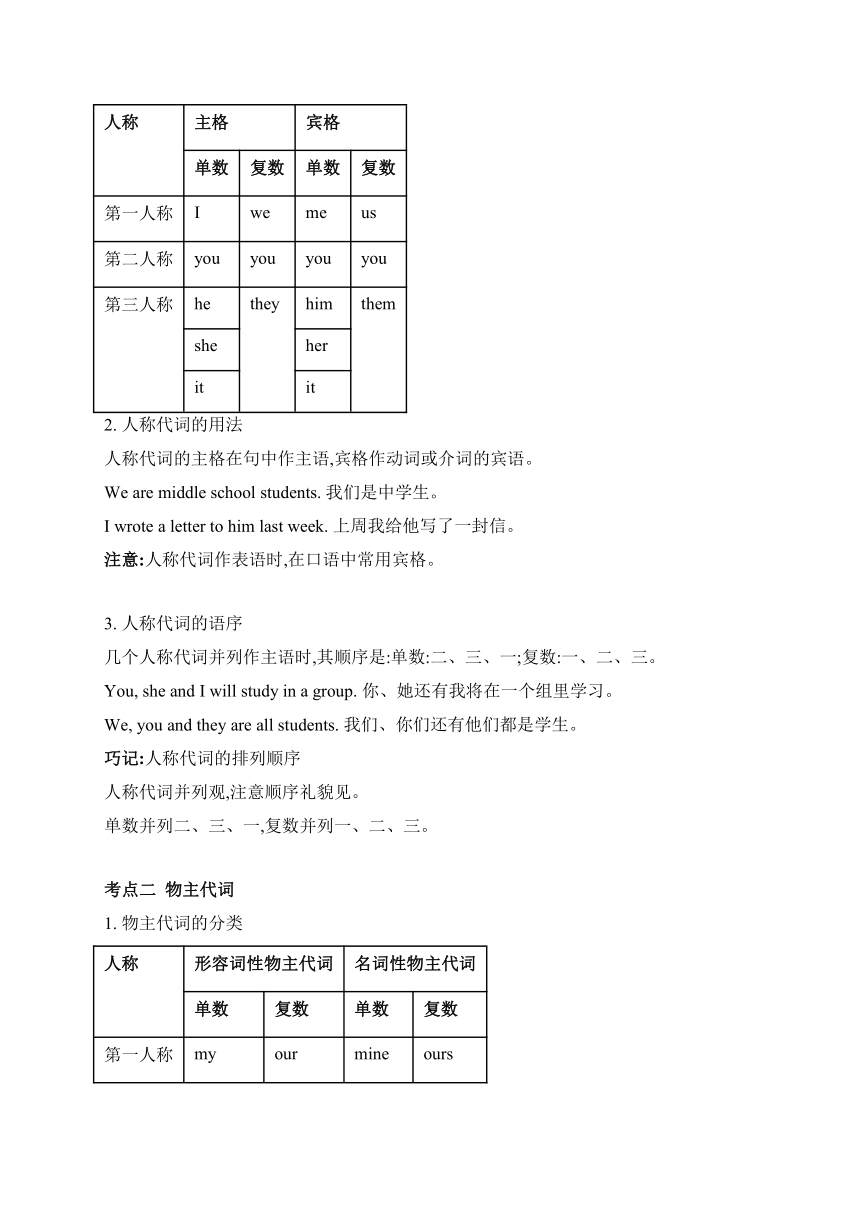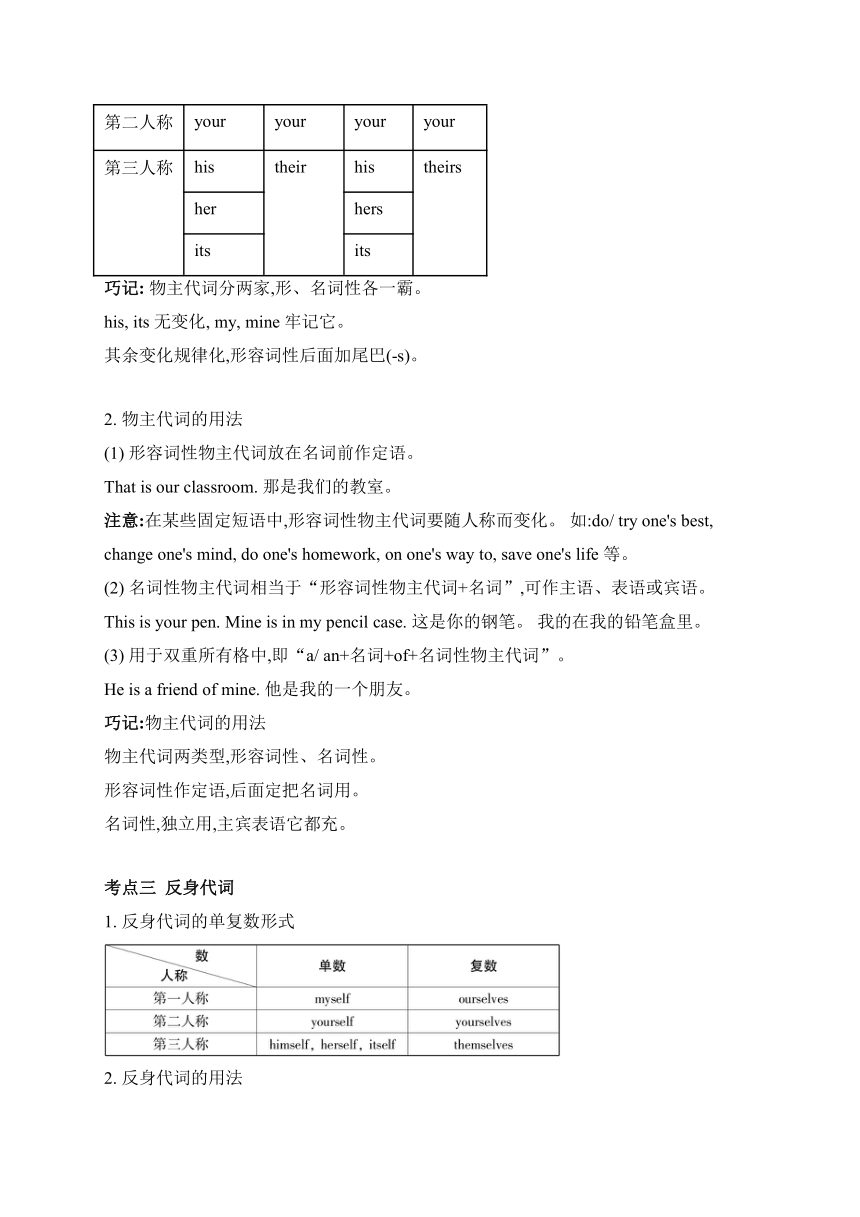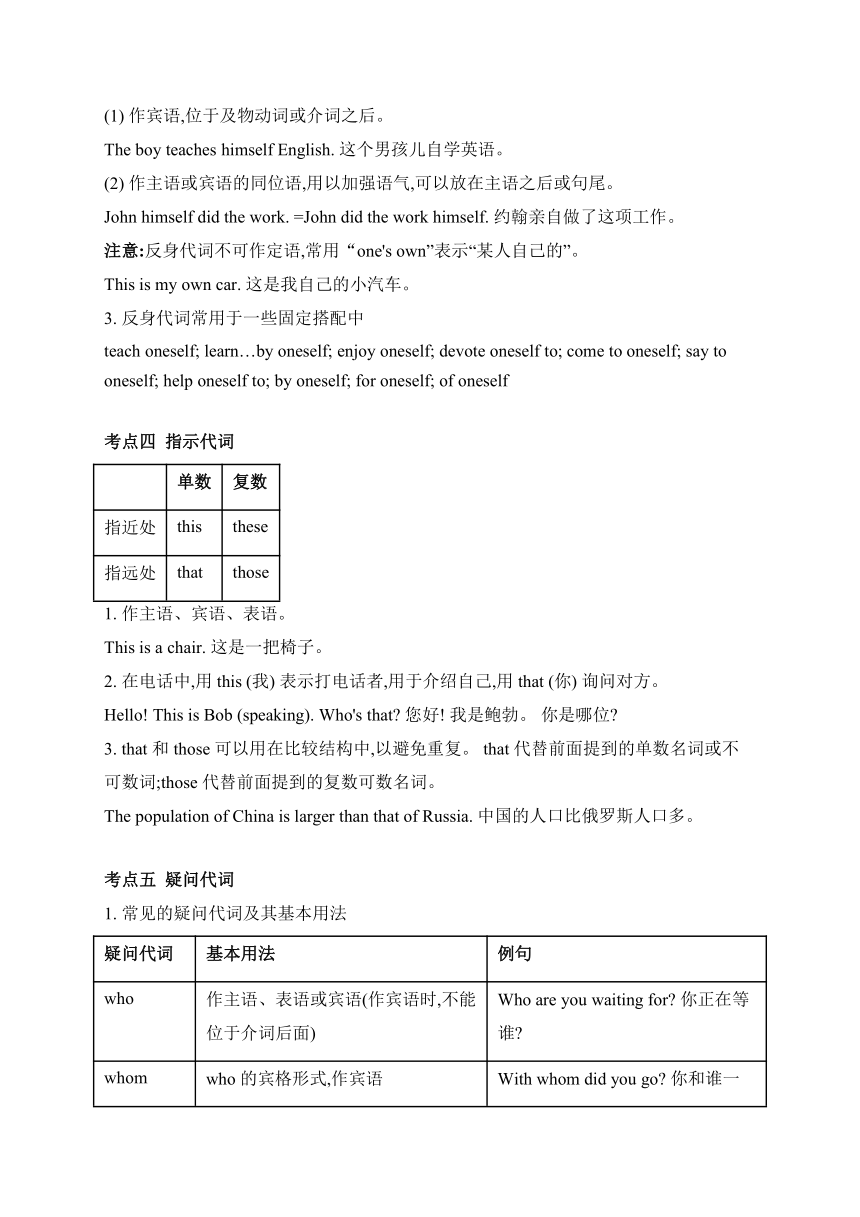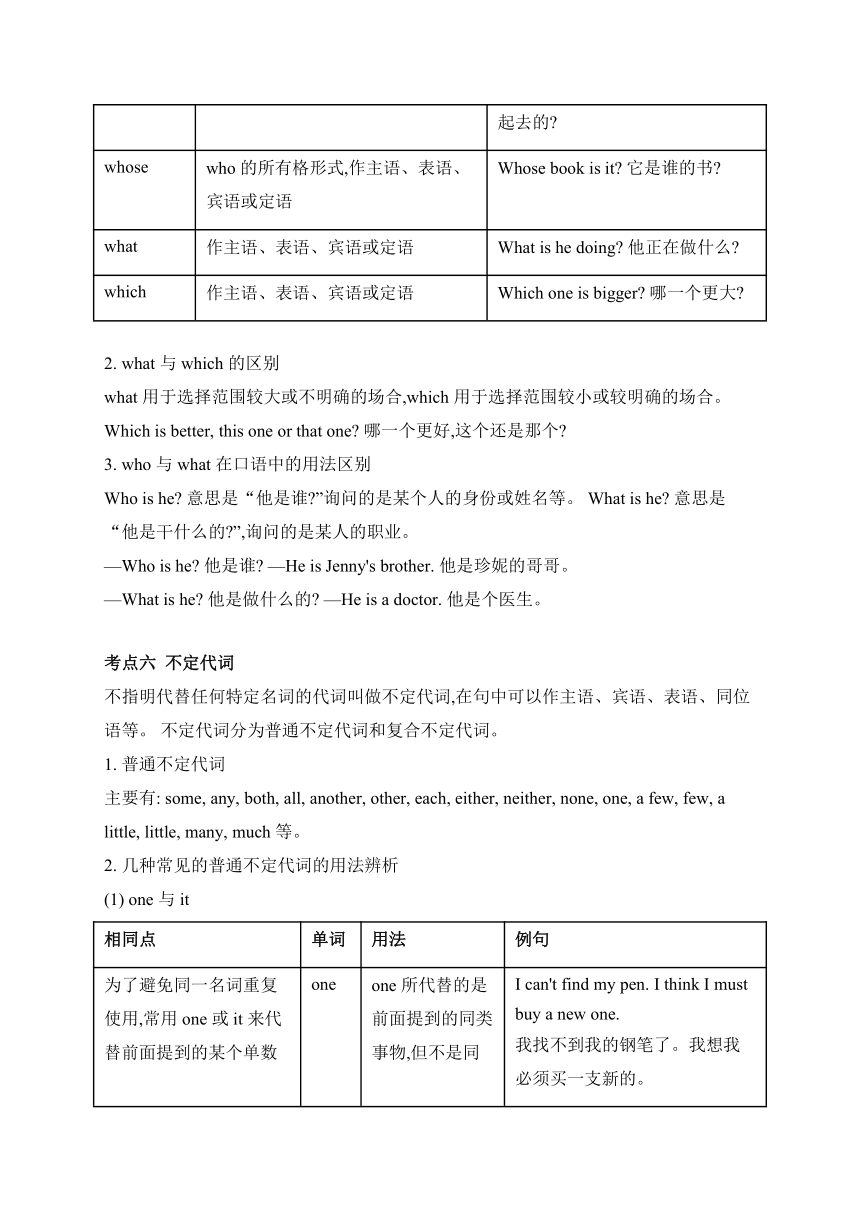2020年中考英语基础语法专练二 代词(含答案)
文档属性
| 名称 | 2020年中考英语基础语法专练二 代词(含答案) |  | |
| 格式 | zip | ||
| 文件大小 | 64.7KB | ||
| 资源类型 | 教案 | ||
| 版本资源 | 通用版 | ||
| 科目 | 英语 | ||
| 更新时间 | 2020-02-23 14:33:50 | ||
图片预览





文档简介
专题二 代词
学前自测(发现考点)
( )1. The old man has two daughters, but ____ of them lives with him.
A. none B. both C. neither D. all
( )2. —I prefer speaking to listening in English learning.
—Oh, really! I think you should be good at ___ of them.
A. some B. any C. both D. all
( )3. She promised that she could finish the work by ____.
A. her B. herself C. she D. hers
( )4. I saw the dog along with a girl ___ was the only guide dog in our city.
A. who B. which C. whom D. what
( )5. —Could you lend me your pen? I left ___ at home. —Certainly.
A. mine B. yours C. one D. it
( )6. —Wow, the English exam is so easy.
—I think so. But I don’t think ____ can pass it.
A. someone B. anyone C. everyone D. no one
( )7. The people in Tokyo will have to get ___ ready before the 2020 Tokyo Olympic Games.
A. anything B. nothing C. something D. everything
( )8. — Wow! There are so many new buildings. I can’t believe it! It used to be a poor village.
— Yes. ____ has changed here.
A. Something B. Nothing C. Everything D. Anything
( )9. ____ David ___ Jessica can go to the concert, because they have no tickets.
A. Neither; nor B. Either; or C. Both; and D. Not only; but also
( )10. The boy said that he couldn't work out the problem by _____.
A. him B. his C. he D. himself
常考考点知识清单(研习考点)
考点一 人称代词
1. 人称代词的分类
人称
主格
宾格
单数
复数
单数
复数
第一人称
I
we
me
us
第二人称
you
you
you
you
第三人称
he
they
him
them
she
her
it
it
2. 人称代词的用法
人称代词的主格在句中作主语,宾格作动词或介词的宾语。
We are middle school students. 我们是中学生。
I wrote a letter to him last week. 上周我给他写了一封信。
注意:人称代词作表语时,在口语中常用宾格。
3. 人称代词的语序
几个人称代词并列作主语时,其顺序是:单数:二、三、一;复数:一、二、三。
You, she and I will study in a group. 你、她还有我将在一个组里学习。
We, you and they are all students. 我们、你们还有他们都是学生。
巧记:人称代词的排列顺序
人称代词并列观,注意顺序礼貌见。
单数并列二、三、一,复数并列一、二、三。
考点二 物主代词
1. 物主代词的分类
人称
形容词性物主代词
名词性物主代词
单数
复数
单数
复数
第一人称
my
our
mine
ours
第二人称
your
your
your
your
第三人称
his
their
his
theirs
her
hers
its
its
巧记: 物主代词分两家,形、名词性各一霸。
his, its 无变化, my, mine 牢记它。
其余变化规律化,形容词性后面加尾巴(-s)。
2. 物主代词的用法
(1) 形容词性物主代词放在名词前作定语。
That is our classroom. 那是我们的教室。
注意:在某些固定短语中,形容词性物主代词要随人称而变化。 如:do/ try one's best, change one's mind, do one's homework, on one's way to, save one's life 等。
(2) 名词性物主代词相当于“形容词性物主代词+名词”,可作主语、表语或宾语。
This is your pen. Mine is in my pencil case. 这是你的钢笔。 我的在我的铅笔盒里。
(3) 用于双重所有格中,即“a/ an+名词+of+名词性物主代词”。
He is a friend of mine. 他是我的一个朋友。
巧记:物主代词的用法
物主代词两类型,形容词性、名词性。
形容词性作定语,后面定把名词用。
名词性,独立用,主宾表语它都充。
考点三 反身代词
1. 反身代词的单复数形式
2. 反身代词的用法
(1) 作宾语,位于及物动词或介词之后。
The boy teaches himself English. 这个男孩儿自学英语。
(2) 作主语或宾语的同位语,用以加强语气,可以放在主语之后或句尾。
John himself did the work. =John did the work himself. 约翰亲自做了这项工作。
注意:反身代词不可作定语,常用“one's own”表示“某人自己的”。
This is my own car. 这是我自己的小汽车。
3. 反身代词常用于一些固定搭配中
teach oneself; learn…by oneself; enjoy oneself; devote oneself to; come to oneself; say to oneself; help oneself to; by oneself; for oneself; of oneself
考点四 指示代词
单数
复数
指近处
this
these
指远处
that
those
1. 作主语、宾语、表语。
This is a chair. 这是一把椅子。
2. 在电话中,用 this (我) 表示打电话者,用于介绍自己,用 that (你) 询问对方。
Hello! This is Bob (speaking). Who's that? 您好! 我是鲍勃。 你是哪位?
3. that 和 those 可以用在比较结构中,以避免重复。 that 代替前面提到的单数名词或不可数词;those 代替前面提到的复数可数名词。
The population of China is larger than that of Russia. 中国的人口比俄罗斯人口多。
考点五 疑问代词
1. 常见的疑问代词及其基本用法
疑问代词
基本用法
例句
who
作主语、表语或宾语(作宾语时,不能位于介词后面)
Who are you waiting for? 你正在等谁?
whom
who 的宾格形式,作宾语
With whom did you go? 你和谁一起去的?
whose
who 的所有格形式,作主语、表语、宾语或定语
Whose book is it? 它是谁的书?
what
作主语、表语、宾语或定语
What is he doing? 他正在做什么?
which
作主语、表语、宾语或定语
Which one is bigger? 哪一个更大?
2. what 与 which 的区别
what 用于选择范围较大或不明确的场合,which 用于选择范围较小或较明确的场合。
Which is better, this one or that one? 哪一个更好,这个还是那个?
3. who 与 what 在口语中的用法区别
Who is he? 意思是“他是谁?”询问的是某个人的身份或姓名等。 What is he? 意思是“他是干什么的?”,询问的是某人的职业。
—Who is he? 他是谁? —He is Jenny's brother. 他是珍妮的哥哥。
—What is he? 他是做什么的? —He is a doctor. 他是个医生。
考点六 不定代词
不指明代替任何特定名词的代词叫做不定代词,在句中可以作主语、宾语、表语、同位语等。 不定代词分为普通不定代词和复合不定代词。
1. 普通不定代词
主要有: some, any, both, all, another, other, each, either, neither, none, one, a few, few, a little, little, many, much 等。
2. 几种常见的普通不定代词的用法辨析
(1) one 与 it
相同点
单词
用法
例句
为了避免同一名词重复使用,常用 one 或 it 来代
替前面提到的某个单数名词
one
one 所代替的是前面提到的同类事物,但不是同一个
I can't find my pen. I think I must buy a new one.
我找不到我的钢笔了。我想我必须买一支新的。
it
it 所代替的是前面提到的那个特指的事物
I bought a new pen yesterday, and I gave it to my sister.
我昨天买了一支新钢笔,我把它给我妹妹了。
(2) some 与 any
相同点
单词
用法
例句
修饰可数或不可数名词
some
陈述句
There are some boys playing football.
有一些男孩们正在踢足球。
疑问句
Would you like some water?
你想喝些水吗?
any
否定句、疑问句或条件状语从句
There isn't any meat in the fridge.
冰箱里没有肉了。
(3) both, all, neither, none, either 与 any
之一
都
都不
适用范围
两者
either
both
neither
三者或以上
any
all
none
固定短语
both … and …(连接两个主语,谓语动词用复数)
either … or …(连接两个主语,谓语动词遵循就近原则)
neither … nor …(连接两个主语,谓语动词遵循就近原则)
(4) little, a little, few 与 a few
很少;几乎没有(表否定)
几个;一点儿(表肯定)
修饰可数名词
few
a few
修饰不可数名词
little
a little
例句
Don't worry! There is a little time left. 别着急! 还有一点儿时间。
He has a few friends here, but he has few good friends.
在这里他有几个朋友,但是几乎没有好朋友。
(5) other(s), the other(s), another
概念成
份数
泛指剩下中的一部分(不用 the)
特指剩下中的全体(要用 the)
作主语/ 宾语
作定语(其后加名词)
作主语/ 宾语
作定语(其后加名词)
单数
another
another book
the other
the other book
复数
others
other books
the others
the other books
3. 复合不定代词
-one
-thing
-body
some-
someone
something
somebody
any-
anyone
anything
anybody
every-
everyone
everything
everybody
no-
no one
nothing
nobody
(1) 一般情况下,由 some 构成的复合不定代词用在肯定句中;由 any 构成的复合不定代词用在疑问句和否定句中;由 no 构成的复合不定代词表示否定意义。
I have something to tell you. 我有事要告诉你。
I can't see anything. 我什么也看不见。
There's nothing I can do. 我什么也做不了。
(2) 形容词或 else 修饰不定代词时,通常位于不定代词之后。
Do you want anything else? 你还想要其他的东西吗?
考点七 代词 it 的用法
1. it 用来指除人以外的一切生物和事物,可指时间、距离、天气、温度、度量等。
—What's the weather like today? 今天天气怎样?
—It's sunny. 很晴朗。
2. it 可用来代替指示代词 this 和 that。
—What's this/ that? 这/ 那是什么?
—It's an apple. 是苹果。
3. it 指婴儿或不明身份的人。
Is it a boy or a girl? 是男孩还是女孩?
4. it 代替动词不定式作形式主语。
It's important for us to work hard. 努力工作对我们来说很重要。
5. it 代替动词不定式作形式宾语。
I found it easy to work out the Math problem. 我发现算出这道数学题很容易。
巩固训练(夯实基础)
一、单项选择
( )1. — _____ notebook is this? —I think it's .
A. Whose; he B. Who; his C. Whose; his D. Who; him
( )2. —Morning, class. Is ____ here? —No, sir. Tom is absent.
A. anybody B. everybody C. nobody D. somebody
( )3. —Can you kick the ball to ___ end of the football field?
—It’s hard for me. I think ___ goalkeepers can make it.
A. another; a little B. another; little C. the other; a few D. the other; few
( )4. —Would you like tea or coffee? — _____. I really don't care.
A. None B. Either C. Neither D. All
( )5. —Mary tried on three dresses, but ____ of them fitted her.
—Don't worry. There are plenty of dresses there.
A. both B. none C. all D. neither
( )6. —Who teaches ____ Japanese? —Nobody. I teach ____.
A. your; mine B. your; my C. you; myself D. you; me
( )7. — ___ Tom ____ Jack has gone to the party because they have no time.
—What a pity!
A. Both; and B. Either; or C. Neither; nor D. None; or
( )8. —Who is Mr Li?
—He is ____ teacher and he teaches ____ English.
A. our; our B. us; us C. our; us D. us; our
( )9. As for learning English, students who read a lot can do much better than _____ who don't.
A. those B. that C. these D. them
( )10. —Hello, may I speak to Jane, please? —Speaking. Who's _____ ?
A. this B. that C. he D. you
二、用所给单词的正确形式填空
1. Little Tom fell off his bike, but he didn’t hurt ______ (he).
2. This ticket is for you. It’s ______ (you) now.
3. What a cute dog! What’s ___ (it) name?
4. ______ (who) bike is this?
5. I think _____ (they) classroom is bigger and brighter than ours.
6. This is an ice box, and ___ (those) is a glass of water.
7. When we grow up, we have to learn to take care of ________ (our).
8. Who help ___ (she) clean the room?
9. This magazine is not _____ (my). It's his.
10. ______ (this) apples are five yuan a kilo.
答案:
学前自测
1-5 CCBBA 6-10 CDCAD
巩固训练
一、
1-5 CBDBB 6-10 CCCAB
二、
1. himself
2. yours
3. its
4. whose
5. their
6. that
7. ourselves
8. her
9. mine
10. These
学前自测(发现考点)
( )1. The old man has two daughters, but ____ of them lives with him.
A. none B. both C. neither D. all
( )2. —I prefer speaking to listening in English learning.
—Oh, really! I think you should be good at ___ of them.
A. some B. any C. both D. all
( )3. She promised that she could finish the work by ____.
A. her B. herself C. she D. hers
( )4. I saw the dog along with a girl ___ was the only guide dog in our city.
A. who B. which C. whom D. what
( )5. —Could you lend me your pen? I left ___ at home. —Certainly.
A. mine B. yours C. one D. it
( )6. —Wow, the English exam is so easy.
—I think so. But I don’t think ____ can pass it.
A. someone B. anyone C. everyone D. no one
( )7. The people in Tokyo will have to get ___ ready before the 2020 Tokyo Olympic Games.
A. anything B. nothing C. something D. everything
( )8. — Wow! There are so many new buildings. I can’t believe it! It used to be a poor village.
— Yes. ____ has changed here.
A. Something B. Nothing C. Everything D. Anything
( )9. ____ David ___ Jessica can go to the concert, because they have no tickets.
A. Neither; nor B. Either; or C. Both; and D. Not only; but also
( )10. The boy said that he couldn't work out the problem by _____.
A. him B. his C. he D. himself
常考考点知识清单(研习考点)
考点一 人称代词
1. 人称代词的分类
人称
主格
宾格
单数
复数
单数
复数
第一人称
I
we
me
us
第二人称
you
you
you
you
第三人称
he
they
him
them
she
her
it
it
2. 人称代词的用法
人称代词的主格在句中作主语,宾格作动词或介词的宾语。
We are middle school students. 我们是中学生。
I wrote a letter to him last week. 上周我给他写了一封信。
注意:人称代词作表语时,在口语中常用宾格。
3. 人称代词的语序
几个人称代词并列作主语时,其顺序是:单数:二、三、一;复数:一、二、三。
You, she and I will study in a group. 你、她还有我将在一个组里学习。
We, you and they are all students. 我们、你们还有他们都是学生。
巧记:人称代词的排列顺序
人称代词并列观,注意顺序礼貌见。
单数并列二、三、一,复数并列一、二、三。
考点二 物主代词
1. 物主代词的分类
人称
形容词性物主代词
名词性物主代词
单数
复数
单数
复数
第一人称
my
our
mine
ours
第二人称
your
your
your
your
第三人称
his
their
his
theirs
her
hers
its
its
巧记: 物主代词分两家,形、名词性各一霸。
his, its 无变化, my, mine 牢记它。
其余变化规律化,形容词性后面加尾巴(-s)。
2. 物主代词的用法
(1) 形容词性物主代词放在名词前作定语。
That is our classroom. 那是我们的教室。
注意:在某些固定短语中,形容词性物主代词要随人称而变化。 如:do/ try one's best, change one's mind, do one's homework, on one's way to, save one's life 等。
(2) 名词性物主代词相当于“形容词性物主代词+名词”,可作主语、表语或宾语。
This is your pen. Mine is in my pencil case. 这是你的钢笔。 我的在我的铅笔盒里。
(3) 用于双重所有格中,即“a/ an+名词+of+名词性物主代词”。
He is a friend of mine. 他是我的一个朋友。
巧记:物主代词的用法
物主代词两类型,形容词性、名词性。
形容词性作定语,后面定把名词用。
名词性,独立用,主宾表语它都充。
考点三 反身代词
1. 反身代词的单复数形式
2. 反身代词的用法
(1) 作宾语,位于及物动词或介词之后。
The boy teaches himself English. 这个男孩儿自学英语。
(2) 作主语或宾语的同位语,用以加强语气,可以放在主语之后或句尾。
John himself did the work. =John did the work himself. 约翰亲自做了这项工作。
注意:反身代词不可作定语,常用“one's own”表示“某人自己的”。
This is my own car. 这是我自己的小汽车。
3. 反身代词常用于一些固定搭配中
teach oneself; learn…by oneself; enjoy oneself; devote oneself to; come to oneself; say to oneself; help oneself to; by oneself; for oneself; of oneself
考点四 指示代词
单数
复数
指近处
this
these
指远处
that
those
1. 作主语、宾语、表语。
This is a chair. 这是一把椅子。
2. 在电话中,用 this (我) 表示打电话者,用于介绍自己,用 that (你) 询问对方。
Hello! This is Bob (speaking). Who's that? 您好! 我是鲍勃。 你是哪位?
3. that 和 those 可以用在比较结构中,以避免重复。 that 代替前面提到的单数名词或不可数词;those 代替前面提到的复数可数名词。
The population of China is larger than that of Russia. 中国的人口比俄罗斯人口多。
考点五 疑问代词
1. 常见的疑问代词及其基本用法
疑问代词
基本用法
例句
who
作主语、表语或宾语(作宾语时,不能位于介词后面)
Who are you waiting for? 你正在等谁?
whom
who 的宾格形式,作宾语
With whom did you go? 你和谁一起去的?
whose
who 的所有格形式,作主语、表语、宾语或定语
Whose book is it? 它是谁的书?
what
作主语、表语、宾语或定语
What is he doing? 他正在做什么?
which
作主语、表语、宾语或定语
Which one is bigger? 哪一个更大?
2. what 与 which 的区别
what 用于选择范围较大或不明确的场合,which 用于选择范围较小或较明确的场合。
Which is better, this one or that one? 哪一个更好,这个还是那个?
3. who 与 what 在口语中的用法区别
Who is he? 意思是“他是谁?”询问的是某个人的身份或姓名等。 What is he? 意思是“他是干什么的?”,询问的是某人的职业。
—Who is he? 他是谁? —He is Jenny's brother. 他是珍妮的哥哥。
—What is he? 他是做什么的? —He is a doctor. 他是个医生。
考点六 不定代词
不指明代替任何特定名词的代词叫做不定代词,在句中可以作主语、宾语、表语、同位语等。 不定代词分为普通不定代词和复合不定代词。
1. 普通不定代词
主要有: some, any, both, all, another, other, each, either, neither, none, one, a few, few, a little, little, many, much 等。
2. 几种常见的普通不定代词的用法辨析
(1) one 与 it
相同点
单词
用法
例句
为了避免同一名词重复使用,常用 one 或 it 来代
替前面提到的某个单数名词
one
one 所代替的是前面提到的同类事物,但不是同一个
I can't find my pen. I think I must buy a new one.
我找不到我的钢笔了。我想我必须买一支新的。
it
it 所代替的是前面提到的那个特指的事物
I bought a new pen yesterday, and I gave it to my sister.
我昨天买了一支新钢笔,我把它给我妹妹了。
(2) some 与 any
相同点
单词
用法
例句
修饰可数或不可数名词
some
陈述句
There are some boys playing football.
有一些男孩们正在踢足球。
疑问句
Would you like some water?
你想喝些水吗?
any
否定句、疑问句或条件状语从句
There isn't any meat in the fridge.
冰箱里没有肉了。
(3) both, all, neither, none, either 与 any
之一
都
都不
适用范围
两者
either
both
neither
三者或以上
any
all
none
固定短语
both … and …(连接两个主语,谓语动词用复数)
either … or …(连接两个主语,谓语动词遵循就近原则)
neither … nor …(连接两个主语,谓语动词遵循就近原则)
(4) little, a little, few 与 a few
很少;几乎没有(表否定)
几个;一点儿(表肯定)
修饰可数名词
few
a few
修饰不可数名词
little
a little
例句
Don't worry! There is a little time left. 别着急! 还有一点儿时间。
He has a few friends here, but he has few good friends.
在这里他有几个朋友,但是几乎没有好朋友。
(5) other(s), the other(s), another
概念成
份数
泛指剩下中的一部分(不用 the)
特指剩下中的全体(要用 the)
作主语/ 宾语
作定语(其后加名词)
作主语/ 宾语
作定语(其后加名词)
单数
another
another book
the other
the other book
复数
others
other books
the others
the other books
3. 复合不定代词
-one
-thing
-body
some-
someone
something
somebody
any-
anyone
anything
anybody
every-
everyone
everything
everybody
no-
no one
nothing
nobody
(1) 一般情况下,由 some 构成的复合不定代词用在肯定句中;由 any 构成的复合不定代词用在疑问句和否定句中;由 no 构成的复合不定代词表示否定意义。
I have something to tell you. 我有事要告诉你。
I can't see anything. 我什么也看不见。
There's nothing I can do. 我什么也做不了。
(2) 形容词或 else 修饰不定代词时,通常位于不定代词之后。
Do you want anything else? 你还想要其他的东西吗?
考点七 代词 it 的用法
1. it 用来指除人以外的一切生物和事物,可指时间、距离、天气、温度、度量等。
—What's the weather like today? 今天天气怎样?
—It's sunny. 很晴朗。
2. it 可用来代替指示代词 this 和 that。
—What's this/ that? 这/ 那是什么?
—It's an apple. 是苹果。
3. it 指婴儿或不明身份的人。
Is it a boy or a girl? 是男孩还是女孩?
4. it 代替动词不定式作形式主语。
It's important for us to work hard. 努力工作对我们来说很重要。
5. it 代替动词不定式作形式宾语。
I found it easy to work out the Math problem. 我发现算出这道数学题很容易。
巩固训练(夯实基础)
一、单项选择
( )1. — _____ notebook is this? —I think it's .
A. Whose; he B. Who; his C. Whose; his D. Who; him
( )2. —Morning, class. Is ____ here? —No, sir. Tom is absent.
A. anybody B. everybody C. nobody D. somebody
( )3. —Can you kick the ball to ___ end of the football field?
—It’s hard for me. I think ___ goalkeepers can make it.
A. another; a little B. another; little C. the other; a few D. the other; few
( )4. —Would you like tea or coffee? — _____. I really don't care.
A. None B. Either C. Neither D. All
( )5. —Mary tried on three dresses, but ____ of them fitted her.
—Don't worry. There are plenty of dresses there.
A. both B. none C. all D. neither
( )6. —Who teaches ____ Japanese? —Nobody. I teach ____.
A. your; mine B. your; my C. you; myself D. you; me
( )7. — ___ Tom ____ Jack has gone to the party because they have no time.
—What a pity!
A. Both; and B. Either; or C. Neither; nor D. None; or
( )8. —Who is Mr Li?
—He is ____ teacher and he teaches ____ English.
A. our; our B. us; us C. our; us D. us; our
( )9. As for learning English, students who read a lot can do much better than _____ who don't.
A. those B. that C. these D. them
( )10. —Hello, may I speak to Jane, please? —Speaking. Who's _____ ?
A. this B. that C. he D. you
二、用所给单词的正确形式填空
1. Little Tom fell off his bike, but he didn’t hurt ______ (he).
2. This ticket is for you. It’s ______ (you) now.
3. What a cute dog! What’s ___ (it) name?
4. ______ (who) bike is this?
5. I think _____ (they) classroom is bigger and brighter than ours.
6. This is an ice box, and ___ (those) is a glass of water.
7. When we grow up, we have to learn to take care of ________ (our).
8. Who help ___ (she) clean the room?
9. This magazine is not _____ (my). It's his.
10. ______ (this) apples are five yuan a kilo.
答案:
学前自测
1-5 CCBBA 6-10 CDCAD
巩固训练
一、
1-5 CBDBB 6-10 CCCAB
二、
1. himself
2. yours
3. its
4. whose
5. their
6. that
7. ourselves
8. her
9. mine
10. These
同课章节目录
- 词法
- 名词
- 动词和动词短语
- 动词语态
- 动词时态
- 助动词和情态动词
- 非谓语动词
- 冠词
- 代词
- 数词和量词
- 形容词副词及其比较等级
- 介词和介词短语
- 连词和感叹词
- 构词法
- 相似、相近词比较
- 句法
- 陈述句
- 一般疑问句和否定疑问句
- 特殊疑问句及选择疑问句
- 反意疑问句
- 存在句(There be句型)
- 宾语从句
- 定语从句
- 状语从句
- 主谓一致问题
- 简单句
- 并列句
- 复合句
- 主谓一致
- 主、表语从句
- 名词性从句
- 直接引语和间接引语
- 虚拟语气
- 感叹句
- 强调句
- 倒装句
- 祈使句
- 句子的成分
- 句子的分类
- 题型专区
- 单项选择部分
- 易错题
- 完形填空
- 阅读理解
- 词汇练习
- 听说训练
- 句型转换
- 补全对话
- 短文改错
- 翻译
- 书面表达
- 任务型阅读
- 语法填空
- 其他资料
